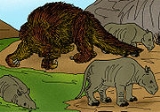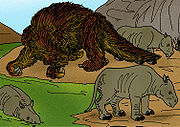
Nesodon
Encyclopedia
Nesodon is a genus of Miocene
mammal
belonging to the extinct
order
Notoungulata
which inhabited southern South America
during the Late Oligocene to Miocene
living from 29.0—16.3 Ma and existed for approximately .
 Nesodon was named by Owen (1846). It was assigned to Toxodontidae
Nesodon was named by Owen (1846). It was assigned to Toxodontidae
by Carroll (1988). It was an early member of the family
Toxodontidae
, which included the well-known Pleistocene
genus Toxodon
. Like almost all toxodontids, Nesodon was endemic to South America
. In particular, fossils of Nesodon are known from late early Miocene (Santacrucian
SALMA) deposits of Argentina
and Chile
.
Three species
of Nesodon are recognized including a larger species, N. imbricatus, and a smaller species, N. conspurcatus. A poorly-known and possibly invalid third species, N. cornutus, was similar to N. imbricatus but may have had a small horn on its head. All species of Nesodon were larger than species of the contemporary toxodontid Adinotherium
.
The dentition
of Nesodon shows features typical of living grazing
(grass
-eating) mammals, but a study of wear on the enamel
of N. imbricatus suggests that it was a browser
(leaf
eater) that may have supplemented its diet with fruit
or bark
.
Miocene
The Miocene is a geological epoch of the Neogene Period and extends from about . The Miocene was named by Sir Charles Lyell. Its name comes from the Greek words and and means "less recent" because it has 18% fewer modern sea invertebrates than the Pliocene. The Miocene follows the Oligocene...
mammal
Mammal
Mammals are members of a class of air-breathing vertebrate animals characterised by the possession of endothermy, hair, three middle ear bones, and mammary glands functional in mothers with young...
belonging to the extinct
Extinction
In biology and ecology, extinction is the end of an organism or of a group of organisms , normally a species. The moment of extinction is generally considered to be the death of the last individual of the species, although the capacity to breed and recover may have been lost before this point...
order
Order (biology)
In scientific classification used in biology, the order is# a taxonomic rank used in the classification of organisms. Other well-known ranks are life, domain, kingdom, phylum, class, family, genus, and species, with order fitting in between class and family...
Notoungulata
Notoungulata
Notoungulata is an extinct order of hoofed, sometimes heavy bodied mammalian ungulates which inhabited South America during the Paleocene to Pleistocene, living from approximately 57 Ma to 11,000 years ago.-Taxonomy:...
which inhabited southern South America
South America
South America is a continent situated in the Western Hemisphere, mostly in the Southern Hemisphere, with a relatively small portion in the Northern Hemisphere. The continent is also considered a subcontinent of the Americas. It is bordered on the west by the Pacific Ocean and on the north and east...
during the Late Oligocene to Miocene
Miocene
The Miocene is a geological epoch of the Neogene Period and extends from about . The Miocene was named by Sir Charles Lyell. Its name comes from the Greek words and and means "less recent" because it has 18% fewer modern sea invertebrates than the Pliocene. The Miocene follows the Oligocene...
living from 29.0—16.3 Ma and existed for approximately .
Taxonomy

Toxodontidae
Toxodontidae is an extinct family of notoungulate mammals known from the Oligocene through the Pleistocene of South America, with one genus, Mixotoxodon, also known from the Pleistocene of Central America. They somewhat resembled rhinoceroses, and had teeth with high crowns and open roots,...
by Carroll (1988). It was an early member of the family
Family (biology)
In biological classification, family is* a taxonomic rank. Other well-known ranks are life, domain, kingdom, phylum, class, order, genus, and species, with family fitting between order and genus. As for the other well-known ranks, there is the option of an immediately lower rank, indicated by the...
Toxodontidae
Toxodontidae
Toxodontidae is an extinct family of notoungulate mammals known from the Oligocene through the Pleistocene of South America, with one genus, Mixotoxodon, also known from the Pleistocene of Central America. They somewhat resembled rhinoceroses, and had teeth with high crowns and open roots,...
, which included the well-known Pleistocene
Pleistocene
The Pleistocene is the epoch from 2,588,000 to 11,700 years BP that spans the world's recent period of repeated glaciations. The name pleistocene is derived from the Greek and ....
genus Toxodon
Toxodon
Toxodon is an extinct mammal of the late Pliocene and Pleistocene epochs about 2.6 million to 16,500 years ago. It was indigenous to South America, and was probably the most common large-hoofed mammal in South America at the time of its existence....
. Like almost all toxodontids, Nesodon was endemic to South America
South America
South America is a continent situated in the Western Hemisphere, mostly in the Southern Hemisphere, with a relatively small portion in the Northern Hemisphere. The continent is also considered a subcontinent of the Americas. It is bordered on the west by the Pacific Ocean and on the north and east...
. In particular, fossils of Nesodon are known from late early Miocene (Santacrucian
Santacrucian
The Santacrucian age is a period of geologic time within the Miocene epoch of the Neogene used more specifically with South American Land Mammal Ages. It follows the Colhuehuapian and precedes the Friasian age....
SALMA) deposits of Argentina
Argentina
Argentina , officially the Argentine Republic , is the second largest country in South America by land area, after Brazil. It is constituted as a federation of 23 provinces and an autonomous city, Buenos Aires...
and Chile
Chile
Chile ,officially the Republic of Chile , is a country in South America occupying a long, narrow coastal strip between the Andes mountains to the east and the Pacific Ocean to the west. It borders Peru to the north, Bolivia to the northeast, Argentina to the east, and the Drake Passage in the far...
.
Three species
Species
In biology, a species is one of the basic units of biological classification and a taxonomic rank. A species is often defined as a group of organisms capable of interbreeding and producing fertile offspring. While in many cases this definition is adequate, more precise or differing measures are...
of Nesodon are recognized including a larger species, N. imbricatus, and a smaller species, N. conspurcatus. A poorly-known and possibly invalid third species, N. cornutus, was similar to N. imbricatus but may have had a small horn on its head. All species of Nesodon were larger than species of the contemporary toxodontid Adinotherium
Adinotherium
Adinotherium is an extinct genus of Toxodontidae, large bodied hoofed ungulates which inhabited South America during the Miocene living from 17.5—11.61 Ma and existed for approximately ....
.
The dentition
Dentition
Dentition pertains to the development of teeth and their arrangement in the mouth. In particular, the characteristic arrangement, kind, and number of teeth in a given species at a given age...
of Nesodon shows features typical of living grazing
Grazing
Grazing generally describes a type of feeding, in which a herbivore feeds on plants , and also on other multicellular autotrophs...
(grass
Grass
Grasses, or more technically graminoids, are monocotyledonous, usually herbaceous plants with narrow leaves growing from the base. They include the "true grasses", of the Poaceae family, as well as the sedges and the rushes . The true grasses include cereals, bamboo and the grasses of lawns ...
-eating) mammals, but a study of wear on the enamel
Tooth enamel
Tooth enamel, along with dentin, cementum, and dental pulp is one of the four major tissues that make up the tooth in vertebrates. It is the hardest and most highly mineralized substance in the human body. Tooth enamel is also found in the dermal denticles of sharks...
of N. imbricatus suggests that it was a browser
Herbivore
Herbivores are organisms that are anatomically and physiologically adapted to eat plant-based foods. Herbivory is a form of consumption in which an organism principally eats autotrophs such as plants, algae and photosynthesizing bacteria. More generally, organisms that feed on autotrophs in...
(leaf
Leaf
A leaf is an organ of a vascular plant, as defined in botanical terms, and in particular in plant morphology. Foliage is a mass noun that refers to leaves as a feature of plants....
eater) that may have supplemented its diet with fruit
Fruit
In broad terms, a fruit is a structure of a plant that contains its seeds.The term has different meanings dependent on context. In non-technical usage, such as food preparation, fruit normally means the fleshy seed-associated structures of certain plants that are sweet and edible in the raw state,...
or bark
Bark
Bark is the outermost layers of stems and roots of woody plants. Plants with bark include trees, woody vines and shrubs. Bark refers to all the tissues outside of the vascular cambium and is a nontechnical term. It overlays the wood and consists of the inner bark and the outer bark. The inner...
.

